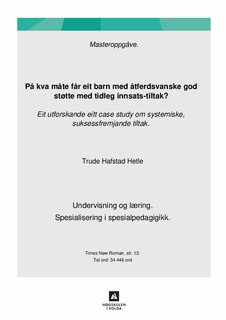| dc.description.abstract | Denne masteravhandlinga fokuserer på tidleg innsats-tiltak for barn med åtferdsvanskar. Bakgrunnen for studien er forsking (Nordahl,et al., 2018) som peiker på spriket mellom Regjeringa sitt aukande fokus på tidleg innsats for barn, til ei statistisk auke i elevar som får spesialundervisninga på slutten av grunnskulen. Tal frå Utdanningsdirektoratet (2017) syner at 3,1 prosent av barna i barnehage har tiltak som er definerte innanfor spesialundervisning, medan heile 10,7 prosent elevane i den norske skulen har spesialundervisning i 10. klasse. På bakgrunn av desse tala er eg nysgjerrig på enkeltindivida som statistikken femner om, og kva støtte einskildbarna og nærpersonane rundt kan få. Ut frå dette er følgjande problemstilling formulert: - På kva måte får eit barn med åtferdsvanske god støtte gjennom tidleg innsats-tiltak? For å nærme seg forskingsfeltet er eit eitt-case design valt. Som case-study opnar for, vert det i denne kvalitative forskingsstudien teke i bruk ei triangulering gjennom fleire metodar for datainnsamling. Både intervju, dokumentanalyse og innsamling av praksisforteljingar er nytta. I det valte eitt-case studie er informantane barnets mor, kontaktlærar og PP-rådgjevar. Funna vart analyserte utifrå ei tematisk analyse (Nilssen, 2012), og presenterte og drøfta utifrå ein utviklingsøkologisk modell (Bronfenbrenner, 1979). Bronfenbrenner sin modell bidreg med å vere teoretisk forankra og fungerer som ein analysemodell. Funna vert drøfta opp mot aktuell nasjonal og internasjonal forsking i feltet, samt dei utvalde teoretiske perspektiva som er presentert i studien sitt kunnskapsgrunnlag. I denne undersøkinga går ein nær eitt barn og det mikrosystemet det er ein del av. Dette for å beskrive korleis informantane vart rettleia og støtta av PTMO rådgjevar (Parent Management Training – Oregon) og pedagogisk-psykologiske rådgjevar frå meso-systemet (Bronfenbrenner, 1979). Funna syner korleis informantane raskt og i tidleg fase sette inn ressurskrevjande tiltak som utøvde god støtte ovanfor barnet si læring og utvikling. Funna er i kontrast til norsk forsking (Nordahl et al., 2018) som syner ei auke i bruk av spesialundervisning. Det er fordi studien peikar på at dei igangsette tidleg innsats-tiltaka kan minske behovet for vedtak om spesialundervisning. Det syner at med støttande tiltak til barnet og dei andre aktørane i mikro-nivået kan nokre gongar falle bort med tidleg-innsats tiltak som støttar dei ressursane deltakarane allereie har eller er på veg til utvikling. I drøftinga vert suksessfaktorane trekt fram og drøfta opp imot korleis mikro-, meso -, ekso-, og makrosystemet har gitt barnet god støtte i kvardagen. Etter Von Tetzchner (2012, s. 55) vert heimen, barnehagen og skulen tolka til å vere i mikrosystemet. | nb_NO |
| dc.description.abstract | Summary
This master thesis focuses on early intervention measures for children with behavioral problems. The background for this study is research (Nordahl, Persson, Brørup, Dyssegaard, Wessel Hennestad, Vaage Wang, Martinsen, Vold, Paulsrud & Johnsen, 2018) that points to the gap between the government`s increasing focus on early effort measures on children, and the statistical increase in children who receives special education at the end of primary school. Figures from the Norwegian education directorate (Utdanningsdirektoratet, 2017) indicates that 3,1prosent of the children in kindergarten have measures defined within special education, while a total of 10,7 prosent of Norwegian students receive special education in 10th grade. Based on these figures, I was curious about the individuals included in the statistics, and what support individual children, family members, schools and kindergartens receive. With this in mind I asked the following question: - In what way is a child with behavioral disabilities provided with good support through early intervention measures? To approach the research field, a one-case design is chosen. As a case study it opens for qualitative research study using a triangulation through several methods of data collection. Both interviews, document analysis and collection of practice narratives have been used. The informants in the chosen one-case study are the child`s mother, contact teacher, and PPTcounselor. The findings were analyzed from a thematic analysis (Nilssen, 2012), and presented and discussed based on a developmental ecological model (Bronfenbrenner, 1979). Bronfenbrenner`s model serves as a theoretical anchor as well as an analysis model. The findings are debated with relevant national and international research in mind, as well as the chosen theoretical perspectives presented in the study`s knowledge base. The findings approach the child and the microsystem the child is part of in order to show how the informants were guided and supported by the PMTO counselor and the pedagogical psychological counselor from the mesosystem (Bronfenbrenner, 1979). The findings point out that the informants quickly and in the early stages introduced resource-absorbing measures that provided the child with good learning and development support. The findings contradict Norwegian research (Nordal et al., 2018) which shows an increase in the use of special education. This is because the study indicates that initiating early effort measures may reduce the need of special education. It shows that with supportive measures for the child and the others at the microsystem can sometimes break away with early effort measures that support the resources that the participant already has or are in the process of development. In the discussion, the success factors are highlighted and discussed to show how micro-, meso-, exo – and macrosystems have provided the child with good support. The child’s family, kindergarten and school are, according to Von Tetzchner (2012, s. 55), considered as part of the microsystem. | nb_NO |
